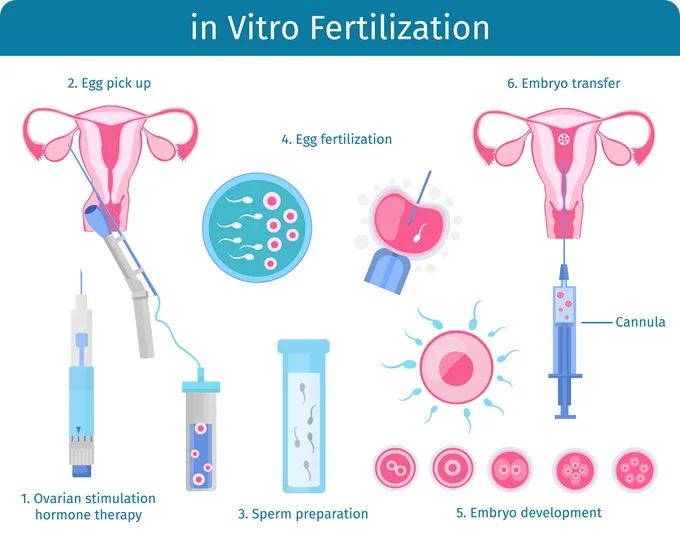In recent years, In Vitro Fertilization (IVF) has emerged as a beacon of hope for couples struggling with infertility. This revolutionary assisted reproductive technology has helped millions worldwide achieve their dream of parenthood. Understanding the intricate process of IVF can alleviate anxieties and provide clarity for those considering this option. Let’s delve into the step-by-step journey of IVF treatment.
1. Introduction to IVF Treatment
IVF involves fertilizing an egg with sperm outside the body, in a laboratory setting. The resulting embryo is then implanted into the uterus to establish a pregnancy.
2. Initial Consultation and Assessment
Before commencing IVF, couples undergo a comprehensive assessment at a fertility clinic. This involves selecting a reputable clinic and providing detailed medical histories to identify potential fertility issues.
Choosing a fertility clinic
Selecting the right fertility clinic is crucial, as it sets the foundation for the entire IVF journey. Factors such as success rates, expertise of medical staff, and available services should be carefully evaluated.
Medical history evaluation
During the initial consultation, both partners undergo a thorough medical evaluation to assess reproductive health. This includes examining hormone levels, conducting imaging tests, and assessing ovarian reserve.
3. Ovarian Stimulation
Once deemed suitable candidates for IVF, the female partner undergoes ovarian stimulation to produce multiple eggs.
Hormone injections
The ovaries are stimulated using hormone injections to promote the growth of multiple follicles, each containing an egg.
Monitoring follicle growth
Regular ultrasound scans and blood tests are performed to monitor follicle development and adjust medication dosages accordingly.
4. Egg Retrieval
When the follicles reach optimal maturity, egg retrieval is scheduled.
Surgical procedure
Under sedation or general anesthesia, a thin needle is guided through the vaginal wall to extract eggs from the follicles.
Anesthesia and recovery
Anesthesia ensures comfort during the procedure, and most women can resume normal activities within a day or two.
5. Sperm Collection and Preparation
Simultaneously, the male partner provides a semen sample, which undergoes processing in the laboratory to isolate healthy, motile sperm.
Semen sample collection
The male partner collects a semen sample through masturbation on the day of egg retrieval.
Laboratory processing
The sample is processed to separate sperm from seminal fluid and other debris, ensuring the highest quality for fertilization.
6. Fertilization Process
In the laboratory, eggs and sperm are combined to facilitate fertilization.
Mixing eggs and sperm
Eggs are carefully incubated with sperm in a controlled environment to maximize the chances of successful fertilization.
Incubation period
Embryologists monitor the embryos over several days, assessing their development and viability.
7. Embryo Culture
The resulting embryos are cultured in the laboratory to promote growth and development.
Growth observation
Embryologists monitor the embryos closely, documenting their progression from fertilization to blastocyst stage.
Quality assessment
Embryo quality is assessed based on factors such as cell division rate, symmetry, and overall morphology.
8. Embryo Transfer
Once optimal embryos are identified, they are transferred into the uterus.
Placement procedure
Using a thin catheter, embryos are carefully transferred into the uterine cavity under ultrasound guidance.
Number of embryos transferred
The number of embryos transferred varies depending on factors such as age, embryo quality, and previous IVF outcomes.
9. Post-Transfer Care
Following embryo transfer, patients are advised to rest and adhere to a prescribed medication regimen.
Rest and recovery
Minimizing physical exertion and stress can enhance the likelihood of implantation and pregnancy.
Medication regimen
Patients may be prescribed medications such as progesterone to support the uterine lining and maintain pregnancy.
10. Pregnancy Test and Follow-Up
Approximately two weeks after embryo transfer, a pregnancy test is performed to detect the presence of Human Chorionic Gonadotropin (hCG) hormone.
Blood test for hCG levels
A blood test is the most accurate method for confirming pregnancy following IVF.
Monitoring early pregnancy signs
Patients are encouraged to monitor for early pregnancy symptoms such as implantation bleeding, breast tenderness, and nausea.
11. Risks and Complications
While IVF offers hope, it’s essential to be aware of potential risks and complications.
Ovarian hyperstimulation syndrome
Excessive response to fertility medications can lead to ovarian hyperstimulation syndrome, characterized by abdominal discomfort and fluid retention.
Multiple pregnancy
The risk of multiple pregnancies, particularly twins or triplets, is higher with IVF due to the transfer of multiple embryos.
12. Success Rates and Factors Affecting IVF Success
IVF success rates vary based on several factors, including age, underlying fertility issues, and lifestyle factors.
Age and fertility
Female age is a significant determinant of IVF success, with younger women experiencing higher success rates.
Lifestyle factors
Maintaining a healthy lifestyle through regular exercise, balanced nutrition, and avoiding harmful habits can positively impact IVF outcomes.
13. Emotional and Psychological Considerations
The IVF journey can be emotionally taxing, requiring support and coping strategies.
Coping with stress and anxiety
Seeking emotional support from loved ones or professional counseling can help navigate the emotional challenges of IVF.
Support resources
Many fertility clinics offer support groups and counseling services to assist patients throughout the IVF process.
14. Alternative and Adjunctive Treatments
In addition to conventional IVF, several alternative and adjunctive treatments may complement the process.
Acupuncture
Some individuals opt for acupuncture to reduce stress and improve reproductive health during IVF treatment.
Nutritional supplements
Certain vitamins and supplements may enhance fertility and support reproductive function, although their efficacy varies.
15. Conclusion
Understanding the step-by-step process of IVF treatment can empower individuals embarking on this journey. By familiarizing themselves with each stage, patients can approach IVF with confidence and optimism, knowing they are taking proactive steps towards building their family.



